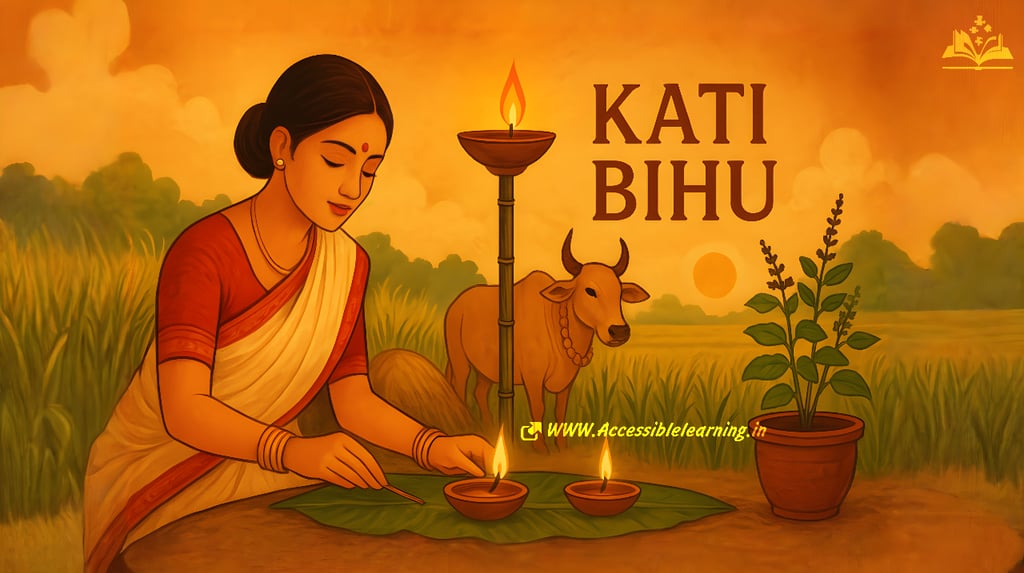
Kati Bihu: The Festival of Lights, Prayers, and Harvest in Assam
Kati Bihu, also known as Kongali Bihu, is a significant Assamese festival celebrated in October with prayers, lamps, and hope for a good harvest. Learn about its rituals, history, cultural importance, and how it differs from other Bihus.
CULTURE/TRADITIONINDIA/BHARATCELEBRATION/FESTIVALS
Keshav Jha
10/14/20253 min read


India is a land of diverse cultures, traditions, and festivals that connect people with nature, spirituality, and community living. In Assam, Bihu is not just a festival but the very essence of life and cultural identity. Among the three major Bihu festivals—Rongali (Bohag Bihu), Bhogali (Magh Bihu), and Kongali (Kati Bihu)—the Kati Bihu holds a unique place. Celebrated in mid-October, it is deeply rooted in agriculture, spirituality, and simplicity. Unlike the joyous Rongali or the feasting Bhogali, Kati Bihu is more austere, spiritual, and symbolic of hope during a time of scarcity.
What is Kati Bihu?
Kati Bihu, also known as Kongali Bihu, is celebrated on the first day of the Assamese month of Kati (mid-October). It falls during the period when paddy crops are still growing in the fields, but the granaries are almost empty. This is why the festival is associated with prayers, lighting of lamps, and seeking blessings for good harvests and prosperity.
Why is Kati Bihu Important?
The importance of Kati Bihu lies in its connection to agrarian life, spirituality, and cultural continuity:
Agricultural significance—It marks the crucial stage of the paddy crop’s growth, when farmers pray for healthy development.
Spiritual significance—Lamps (diyas) are lit in homes, near sacred tulsi plants, and in the fields to invoke divine blessings.
Cultural continuity—The festival reflects the resilience and faith of Assamese people, showing how they balance scarcity with hope.
Rituals and Traditions of Kati Bihu
1. Lighting of Lamps (Akash Banti)
People light earthen lamps in front of the Tulsi plant (Holy Basil) in their courtyards.
Lamps are also placed in paddy fields, near granaries, and in front of cow sheds.
The lamps, known as Akash Banti (sky lamps), are believed to guide spirits and divine forces, bringing protection and blessings.
2. Tulsi Plant Worship
The tulsi plant is decorated with an earthen lamp, and prayers are offered.
Tulsi is considered sacred in Hindu tradition, symbolizing purity, protection, and divine energy.
3. Akash Banti for Ancestors and Deities
Farmers light lamps high on bamboo poles (called Akash Banti) to show reverence to ancestors and to seek blessings from gods for good harvests.
4. Prayers for Cattle and Crops
Cows, being essential to farming, are often worshipped and offered special feed.
People pray for the protection of crops from pests and natural calamities.
The Spirit of Kati Bihu—A Time of Scarcity and Hope
Unlike Rongali Bihu, filled with songs, dances, and feasting, Kati Bihu is simple and solemn. This is because the season represents a lean period:
The previous harvest is almost exhausted.
The new crop is still growing.
Families face scarcity of food and resources.
Yet, the festival is marked with hope, light, and prayers, symbolizing resilience in times of hardship.
Scientific and Cultural Perspectives
Agricultural Science—Lighting lamps in the fields was traditionally believed to keep insects away from crops and prevent damage. The smoke from oil lamps also acts as a natural repellent.
Spiritual Belief—The lamps are symbolic of energy, optimism, and divine blessings.
Cultural Bonding—Communities gather, families come together, and farmers collectively pray for prosperity, reflecting unity in difficult times.

Kati Bihu in Modern Times
While urbanization and changing lifestyles have altered some practices, the essence of Kati Bihu remains alive:
In villages, farmers still perform rituals with devotion.
In cities, people light lamps at home, visit temples, and connect spiritually with their roots.
Social organizations and cultural groups arrange events to keep the tradition alive among the younger generation.
Comparison with Other Bihus
Rongali Bihu (April)—Celebrates spring, love, and the sowing season.
Bhogali Bihu (January)—Celebrates harvest and abundance with feasts.
Kati Bihu (October)—A spiritual festival of prayers during scarcity, focusing on hope and future prosperity.
Kati Bihu is not just a festival but a reflection of life’s philosophy—to remain hopeful even in times of scarcity. It teaches patience, faith, and the importance of staying connected to nature. For the people of Assam, Kati Bihu is a reminder that light will always overcome darkness and that prayers, hard work, and hope eventually lead to abundance.
FAQs
Q. When is Kati Bihu celebrated?
Kati Bihu is celebrated in mid-October, on the first day of the Assamese month of Kati.
Q. Why is Kati Bihu called Kongali Bihu?
It is called Kongali Bihu because this period is marked by scarcity (Kongali) of food, as the previous harvest is over and the new crop is still growing.
Q. What is the main ritual of Kati Bihu?
The main ritual is lighting lamps (Akash Banti) near tulsi plants, in fields, and on bamboo poles to seek blessings for crops and ancestors.
Q. How is Kati Bihu different from other Bihus?
Unlike Rongali and Bhogali Bihu, which are festive and joyous, Kati Bihu is solemn and centered around prayers, simplicity, and spiritual reflection.
Q. What is the cultural importance of Kati Bihu?
Kati Bihu symbolizes hope, resilience, and the bond between people, nature, and divine forces, making it an essential part of Assamese culture.
Subscribe to our newsletter
All © Copyright reserved by Accessible-Learning
| Terms & Conditions
Knowledge is power. Learn with Us. 📚


